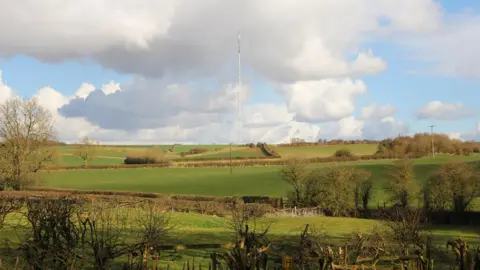Ravens set up home on TV and radio mast
 Arqiva
ArqivaA family of ravens have set up home on a Lincolnshire TV and radio transmitter.
The birds have built a nest about a third of the way up the 1,154ft (about 350m) Belmont mast, between Market Rasen and Louth.
Owner Arqiva worked with the RSPB to ensure the breeding pair were not disturbed during maintenance work.
Mark Thomas from the RSPB said it was unusual to find the species as far east as Lincolnshire.
"It's a bird that is traditionally being found in the west of the UK – particularly Wales, Cumbria, places like that," he said.
"But in the last 25 years a population of these birds has begun to spread to the east, and they're now breeding in many central locations."
Mr Thomas said Lincolnshire was now home to about 20 breeding pairs, with the birds traditionally nesting on crags, rock faces or very large trees.
"Of course, in Lincolnshire there are not many of those," Mr Thomas said.
"So what they've basically done is they've substituted that by using anything that is tall, [such as] a radio mast, a bridge, anything like this."
The Belmont birds have built their nest out of twigs and other materials on a platform on the steel tower.
The mast is used to transmit television and radio broadcasts to about two million people across Lincolnshire and East Yorkshire.
The chicks have left the nest, although Mr Thomas said they were likely to use the site again.
 Richard Croft/Geograph
Richard Croft/GeographRavens are the largest members of the crow family and are famously kept at the Tower of London.
There is a legend that the London landmark would fall down if the ravens ever left – and Caroline Morris, head of sustainability at Arqiva, said she hoped that fate would not befall the Belmont transmitter.
"We're proud to have supported this remarkable species as its numbers continue to grow across the east of England," she said.
"They've certainly been one of the more unusual visitors to one of our structures."
Listen to highlights from Lincolnshire on BBC Sounds, watch the latest episode of Look North or tell us about a story you think we should be covering here.
